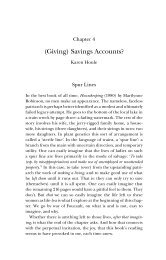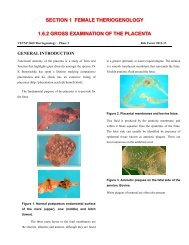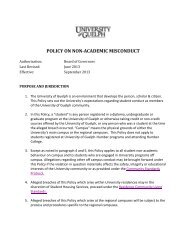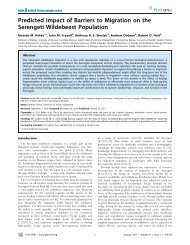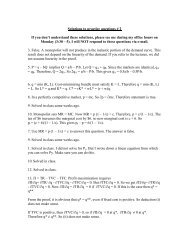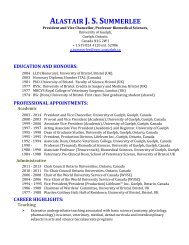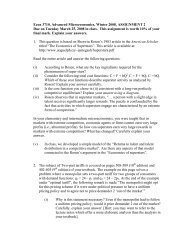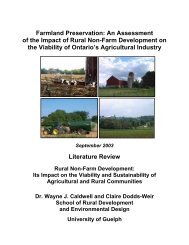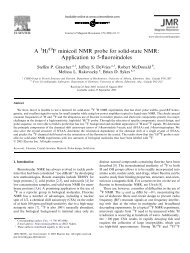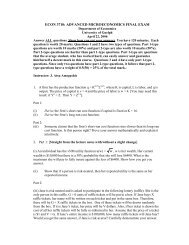The biology of Canadian weeds. 117. Taraxacum officinale G. H. ...
The biology of Canadian weeds. 117. Taraxacum officinale G. H. ...
The biology of Canadian weeds. 117. Taraxacum officinale G. H. ...
Create successful ePaper yourself
Turn your PDF publications into a flip-book with our unique Google optimized e-Paper software.
ther radiation, and a change in the rate <strong>of</strong> growth and development<br />
(Pozolotina 1996). <strong>The</strong> potential use <strong>of</strong> electromagnetic<br />
radiation in the form <strong>of</strong> microwaves has been studied<br />
for T. <strong>of</strong>ficinale control on railway tracks in Europe<br />
(Kunisch et al. 1992). Plants were killed by microwave<br />
treatment for 16 s, which increased the soil temperature by<br />
more than 40°C in controlled environments (Kunisch et al.<br />
1992).<br />
13. Response to Herbivory, Disease and Higher<br />
Plant Parasites<br />
Herbivory<br />
(a) Mammals, including both domestic and wild animals.<br />
Mammals, including rabbits, cats, chipmunks, ground squirrels,<br />
groundhogs (woodchucks), prairie dogs, pocket<br />
gophers, deer, moose, elk, black bears and grizzly bears, eat<br />
the leaves <strong>of</strong> T. <strong>of</strong>ficinale (Ellison and Aldous 1952; Powell<br />
1972; Angier 1980; Jackson 1982; Swihart 1990).<br />
Dandelion is an excellent pasture feed for dairy cattle,<br />
improving milk flow and quality (Jackson 1982). However,<br />
manure from cattle can contain viable seeds and, when<br />
applied to cropland, may serve as a source <strong>of</strong> introduction<br />
and dispersal (Mt. Pleasant and Schlather 1994). Domestic<br />
animals, such as goats and pigs, eat the seeds (Powell 1972),<br />
and sheep and geese have been used for biological control <strong>of</strong><br />
T. <strong>of</strong>ficinale, with sheep being more effective than geese in<br />
controlling the weed in Christmas tree plantations in North<br />
Carolina, USA. (Müller et al. 1999).<br />
(b) Birds and/or other vertebrates. <strong>Taraxacum</strong> <strong>of</strong>ficinale<br />
seeds are eaten by at least 12 songbirds native to Canada<br />
(Jackson 1982). Birds such as siskins, common house finches,<br />
goldfinches and sparrows eat the seeds (Longyear 1918;<br />
Angier 1980). Leaves, inflorescences and seed heads are<br />
eaten by chickens, ducks, geese, Canada geese, grouse, partridges,<br />
pheasants, prairie chickens, quail, ruffed grouse and<br />
sage grouse (Eckert et al. 1973; Angier 1980; Jackson<br />
1982). Seed predation by birds, ants and rodents reduced<br />
seed number and seedling emergence <strong>of</strong> T. <strong>of</strong>ficinale more<br />
where ground cover was dense (in hollows) than in less<br />
dense communities (on ridges) (Reader and Beisner 1991).<br />
Thus, ground cover can restrict seedling emergence by providing<br />
a habitat for seed predators (Reader 1991b).<br />
(c) Insects and Arachnids. Due to its early flowering and<br />
rich supply <strong>of</strong> nectar, T. <strong>of</strong>ficinale is a food source for many<br />
insects, including butterflies, bee flies, hawk moths and<br />
bumblebees in Canada (Jackson 1982). Judd (1971) collected<br />
152 species <strong>of</strong> insects in the Orders Collembola,<br />
Thysanoptera, Hemiptera, Homoptera, Coleoptera, Diptera<br />
and Hymenoptera from the inflorescences <strong>of</strong> T. <strong>of</strong>ficinale in<br />
Ontario.<br />
<strong>The</strong> cynipid wasp, Phanacis taraxaci (Ashmead), forms<br />
galls on the abaxial surfaces <strong>of</strong> maturing T. <strong>of</strong>ficinale leaves<br />
in Canada and the USA. <strong>The</strong>se galls influence the partitioning<br />
<strong>of</strong> photoassimilates by actively redirecting carbon<br />
resources from unattacked leaves (Paquette et al. 1993;<br />
Bagatto et al. 1996). <strong>The</strong> first record <strong>of</strong> European dandelion<br />
leaf-gall midge, Cystiphora taraxaci Kieffer, in north-cen-<br />
STEWART-WADE ET AL — TARAXACUM OFFICINALE G. H. WEBER EX WIGGERS 841<br />
tral Saskatchewan was by Peschken et al. (1993). This<br />
midge induces purple-red pustule galls on the upper surfaces<br />
<strong>of</strong> leaves (Neuer-Markmann and Beiderbeck 1990). T. <strong>of</strong>ficinale<br />
is also a host for the braconid Pholetesor ornigis<br />
(Weed), a parasitoid that attacks larvae <strong>of</strong> the leaf miner<br />
Phyllonorycter blancardella (Fabr.), which is a pest <strong>of</strong> apple<br />
in Canada (Hagley and Barber 1992).<br />
<strong>Taraxacum</strong> <strong>of</strong>ficinale also acts as a host for several aphid<br />
species. In Canada, Aphis knowltoni Hottes & Frison has<br />
been collected from roots <strong>of</strong> T. <strong>of</strong>ficinale (Wood-Baker<br />
1980), and Aphis taraxacicola (Börner) has been recorded<br />
on T. <strong>of</strong>ficinale in Japan (Sugimoto and Takahashi 1996). In<br />
the USA, T. <strong>of</strong>ficinale is a favourite secondary weed host <strong>of</strong><br />
the green peach aphid (Myzus persicae Sulzer) during the<br />
summer (Kaakeh and Hogmire 1991). In the UK, it is a natural<br />
host <strong>of</strong> the lettuce root aphid, Pemphigus bursarius (L.)<br />
(Gange and Brown 1991).<br />
In the USA, the weevil, Ceutorhynchus punctiger<br />
Gyllenhall, attacks T. <strong>of</strong>ficinale inflorescence buds, seeds<br />
and leaves (McAvoy et al. 1983). McAvoy et al. (1983) suggested<br />
that C. punctiger could be used as a biocontrol to<br />
reduce the viable seed population <strong>of</strong> T. <strong>of</strong>ficinale but host<br />
specificity and key mortality factors <strong>of</strong> the weevil must first<br />
be studied. Another weevil, Barypeithes pellucidus<br />
(Boheman), feeds lightly on T. <strong>of</strong>ficinale leaves but moderately<br />
on the epidermis <strong>of</strong> the scapes (Galford 1987). In laboratory<br />
experiments, the boll weevil, Anthonomus grandis<br />
Boheman, a pest <strong>of</strong> cotton, feeds and survives on T. <strong>of</strong>ficinale<br />
cuttings for 8–10 d by eating pollen and seed heads.<br />
<strong>The</strong>refore, feral boll weevils, emerging prior to cotton flowering,<br />
may initially survive on T. <strong>of</strong>ficinale plants and subsequently<br />
infest cotton crops in the USA (Haynes and Smith<br />
1992). <strong>The</strong> black vine weevil, Otiorhynchus sulcatus (Fab.),<br />
also feeds on T. <strong>of</strong>ficinale in Japan and the UK; although<br />
some resistance is conferred by mycorrhizal associations<br />
(Masaki et al. 1984; Gange et al. 1994).<br />
<strong>Taraxacum</strong> <strong>of</strong>ficinale is a host for many other insects in<br />
the USA. <strong>The</strong>se include several caterpillars, such as those <strong>of</strong><br />
the cabbage looper (Trichoplusia ni Hübner), the yellowstriped<br />
armyworm (Spodoptera ornithogalli) (Dussourd and<br />
Denno 1994), and the tiger moth (Diacrisia virginica Fabr.),<br />
which prefers to feed on T. <strong>of</strong>ficinale over grasses (Dethier<br />
1993). It is also a host for the small milkweed bug, Lygaeus<br />
kalmii Stal. (Fox and Caldwell 1994), but significantly<br />
fewer <strong>of</strong> these bugs survived on T. <strong>of</strong>ficinale than on milkweed<br />
species. Nymphs <strong>of</strong> the potato leafhopper, Empoasca<br />
fabae (Harris), develop and adults survive and reproduce on<br />
T. <strong>of</strong>ficinale (Lamp et al. 1984). It was suggested that the<br />
leafhopper may have a role as a biological weed control<br />
agent. Crickets [Allonemobius allardi (Alexander &<br />
Thomas)] have also been recorded feeding on leaves <strong>of</strong> T.<br />
<strong>of</strong>ficinale (Jacobs et al. 1992). Root feeding larvae <strong>of</strong> the<br />
Japanese beetle (Popillia japonica Newman) and the southern<br />
masked chafer (Cyclocephala lurida Bland), commonly<br />
called white grubs, feed upon and reduce root biomass <strong>of</strong> T.<br />
<strong>of</strong>ficinale (Crutchfield and Potter 1995).<br />
In Japan, the coccinellid Coccinula crotchi (Lewis) survives<br />
on inflorescences <strong>of</strong> various species, including T.<br />
<strong>of</strong>ficinale (Hoshikawa 1995). Also, adult scarab beetles,



